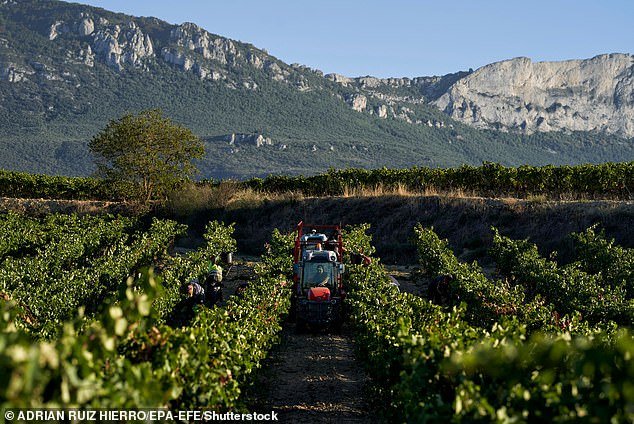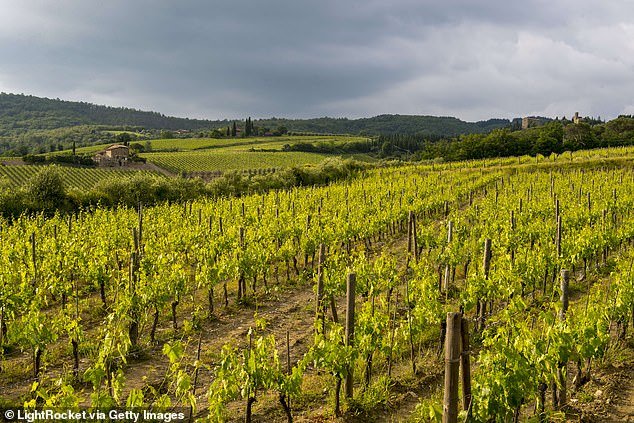
Wine lovers have received some disappointing news ahead of summer, as they have been warned they may have to say goodbye to Chardonnay and Sauvignon Blanc and hello to less common plonk like Grenache and Monastrell.
As global temperatures rise, wine drinkers will have to make do with rarer grape varieties that can withstand hotter and drier environments, experts say.
Wine is naturally adapted to hot and dry climates due to its origins in the Mediterranean region, where the most popular grapes rely heavily on irrigation: the practice of applying controlled amounts of water to land to grow plants.
But the process faces its own challenges as climate change makes water scarcer.
Wine has already become more alcoholic and has a sweeter taste, with vineyards harvesting almost three weeks earlier than just forty years ago.

Wine lovers may have to settle for lesser-known grapes, as rising temperatures could make 70 percent of wine-growing areas around the planet unsuitable for grape growing.


Seasonal workers pick bunches of grapes during the grape harvest in a vineyard in the area known as Rioja Alavesa, in the village of Laguardia, Basque Country, Northern Spain


Vineyard in the Chianti region of Tuscany, Italy
The higher temperatures in the growing season make it more difficult for growers to achieve balance in the fruit – and therefore also in the final wine.
But global warming will cause severe droughts and heat waves that could render as many as 70 percent of wine-growing areas across the planet unsuitable – if global temperatures rise by more than 2 degrees Celsius.
Shocking figures show that the world is currently heading for a rise of almost 3 degrees Celsius.
About nine out of 10 vineyards that produce favorite grapes such as Spanish Merlots and Italian Sauvignon Blancs could soon be forced to close shop.
According to research published in The Times, vineyards in and around coastal and low-lying areas of Spain, Italy, Greece and Southern California could be made unsuitable for viticulture.
And while this means wine drinkers will have to make do with lesser-known, drought-resistant grapes like Monastrell and Grenache, it means the drink will keep flowing.
Adjustments to which grape varieties are grown and the process of how they are grown are being discussed in vineyards around the world in an attempt to address this problem.
In the most extreme case, ‘what type of grapes are grown’ can mean a complete change of grape variety.
“The market must accept that different varieties are consumed than they are used to,” says Cornelis van Leeuwen of the Bordeaux Sciences Agro wine growing school.
“Most international varieties, such as Sauvignon Blanc, Chardonnay and Merlot, are really not adapted to a warmer, drier climate.”
Bordeaux approved the use of six new grape varieties in its vineyards two years ago.
More than half of the world’s vineyards are planted with twelve grape varieties, but luckily for wine lovers there are thousands more available.
In addition to grape varieties, growers can sometimes ‘create cooling’ by planting seeds on differently oriented slopes that receive less or ‘cooler’ sun/more wind, or at higher altitudes.
Some growers also believe they can mitigate the effects of climate change by using different clones of their existing grape varieties – versions that ripen later or more reluctantly.
A study published in the journal Nature Reviews Earth & Environment examined how climate change will affect viticulture on a global scale.
It showed that if temperatures were kept at 2 degrees Celsius, about 25 percent of current wine-growing areas could benefit.
Another quarter would remain eligible.
But anything above 2°C would lead to the catastrophic result of 70 percent of the world’s vineyards being unable to grow the most famous and beloved wine grapes.
Statistics from NASA and the National Oceanic and Atmospheric Administration show a world that is already more than 1°C warmer than before the Industrial Revolution.
Eight of the ten warmest years on record occurred in the past decade.
The past two years have seen record temperatures from Canada to Sicily, forest fires in Australia, Portugal, Greece and California, and floods in Australia and Germany.
New growing areas will also be opened in Britain as the climate becomes more suitable for cultivation.
Sussex and Kent are already leading the way with their hugely popular estates at Rathfinny and Denbies, with chalk soils and rolling landscapes perfect for grape growing.


